#Japanese air self defense force
Text

Exercise Pitch Black 2024 // Australia
#military#milblr#japan#Japanese Air Self-Defense Force#JASDF#Mitsubishi F-2#F-2#fighter#fighter jet#KC-30A#RAAF#RAAF Base Amberley#Australia#Royal Australian Air Force#Airbus A330#33 Squadron#Ex. Pitch Black 2024#Pitch Black 2024#Exercise Pitch Black 2024#Exercise Pitch Black#Mitsubishi Heavy Industries#Lockheed Martin#Viper#Viper Zero#F-2A#Mitsubishi F-2A
2 notes
·
View notes
Text


Plane doodles
Mitsubishi F-2 | F/A-18F Super Hornet
#aviation#mitsubishi#mitsubishi f-2#f-2#f/a 18 hornet#jasdf#japanese air self-defense force#us navy#f/a 18 super hornet#aircraft#plane art#doodle#aviation art#doodle art
5 notes
·
View notes
Photo
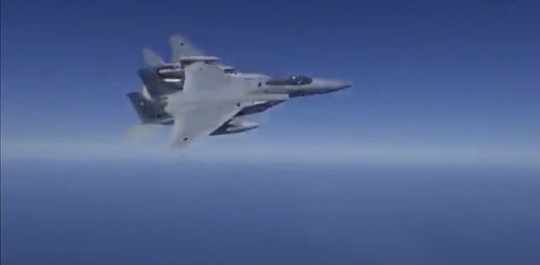







Public Affairs Office in the Sky - Soratobu Kouhoushitsu (Ep 1)
Japan should make a military action movie like Top Gun, would be cool to see F-15J dogfighting with North Korean MiG-29.
#public affairs office in the sky#soratobu kouhoushitsu#go ayano#ayano go#japanese drama#j drama#jdrama#dorama#japan#japan air self-defense force#f-15#mig-29#top gun
15 notes
·
View notes
Text

at all costs.
She didn’t know it would feel like this. The media, the people, and the news made it seem like the Japanese Defense Force was unstoppable — always victorious. But it was all a facade — a rose-tinted image to ease the public’s worries and fears.
She sat on the cold tiled floor, a blink away from hurling whatever was left of my already empty stomach into the toilet.
“You did your best. You did your best.” She chanted. The image of a town, once full of life and happiness, forced to its knees by just one kaiju appearance surfaced. She can still smell the sizzling wires and rubber. How the dust-filled air engulfed her lungs, covering every inch. And the sounds of silent pleas and whimpers between the rubbles haunt her all night long.
It was a harsh wake-up call, a sledgehammer to the back of her head.
“Why— why!?” Why, what? She doesn’t even know. She was barely coherent, drowning in the darkest pits of her thoughts — a scene constantly tormenting her. “Why!?”
“You need to stop, or else you’re going to hurt yourself.”
“Vice-captain Hoshina?” He sounded different, quite unlike his usual self — quieter, more subdued. Or is this how he truly is — entirely the opposite of his fun, carefree, and always-laughing self? Was it all a front to protect himself — to hide away his vulnerabilities?
“How can we move on from this?” She asked. She didn’t need to clarify; her meaning was as clear as the vivid images inside her head.
“We don’t.”
And he was right. They are the Japanese Defense Force, and it is their duty to save and protect the citizens at all costs.
“Go to sleep. We still have work tomorrow.”

and i'm baccckkkk!! 🙌 🎉 it's me, hi. how have you guys been?
i had this idea waaaaay before i took a break from writing/posting, but since life tends to smack me in the face, i couldn't write it until the last leg of july.
anyway, here is a what-if scenario: "what if they, the third division of the japanese defence force, encountered a mission where not all citizens were saved during a kaiju attack? how would it affect them?"
and this is what i came up with ✌
enjoyyy xx
#jeuel: writes#jeuel: drabbles#jeuel: anime/manga#jeuel: anime/manga drabbles#anime and manga#kaiju no. 8#kn8#kaijuu 8 gou#kaiju no. 8 drabbles#kn8 drabbles#kn8 hoshiro soshiro#hoshiro soshiro#soshiro hoshina#kaiju no 8 x reader#kn8 x reader#hoshina soshiro x reader
86 notes
·
View notes
Text

The Story Of The Soviet Pilot Who Defected To Japan With A Secretive MiG-25 Foxbat
September 6, 2016 Military Aviation, Military History, Russia, Troubled Areas
Image credit: Alex Beltyukov
OTD in 1976, Viktor Belenko, “stole” a MiG-25 and landed in Japan.
The then Lieutenant Belenko was a pilot with the 513th Fighter Regiment, 11th Air Army, based in Chuguyevka, Primorsky Krai, in the east of the country. When he brought his MiG-25 “Foxbat” to Hakodate he gave the Western intelligence officers the opportunity to give a first close look at one of the most secretive airplanes of those years: a supersonic interceptor featuring a powerful radar, four air-to-air missiles and a top speed above Mach 3.
In order to assist the American experts in evaluating the aircraft, Belenko brought with him the pilot’s manual for the MiG-25 “Foxbat”, expecting to assist American pilots in evaluating and testing the aircraft. Even if the Japanese government didn’t originally give full access to the plane, the Americans were later invited to examine the aircraft extensively: the MiG was dismantled for such purpose and later returned to the Soviet Union.
In his “MiG pilot” book (1983) John Barron claims that Viktor Belenko’s defection was completely voluntary and was the result of Belenko’s distrust on communist regime.
The MiG was delivered to Japan without the missiles, which were to be introduced in the Belenko’s training later on. The mission was launched earlier than initially planned, because the KGB was about to stop Viktor Ivanovich Belenko from defection.
Although pilot defections during the Cold War were not a rarity, what made Belenko’s defection unique was the fact that the MiG-25 was largely unknown in the West. This is the main point to bear in mind when thinking about Belenko and, unfortunately, this fact is often forgotten.
The ideological background for the events which took place in 1976 is deeply rooted in the beginnings of the post-war period. As the Cold War was in progress there were many incidents and crises which closely led to a confrontation between the two superpowers. One of these events was Francis Gary Powers’s U-2 spy flight on of May 1, 1960.
Power’s U-2 took off from USAF Peshawar Air Base in Pakistan for a GRAND SLAM mission, to investigate the Soviet missile and plutonium production plants. Targets were Sverdlovsk, Plesetsk (ICBM sites) and Mayak – a plutonium plant.
The U-2 was a plane designed to fly well above the Soviet air defense Surface to Air Missile systems. Its operational ceiling was out of the range of the Soviet interceptors and missiles but Powers’ flight was expected, all of the units and surface-to-air defenses were put on alert. The MiG pilots were ordered to ram the aircraft if necessary. The U-2 was eventually shot down by an S-75 Dvina missile near Degtayrsk in the Ural region. Because of high g-force Powers had no chance of reaching the airplane’s self-destruction button and had to eject.
What is interesting is the fact that SAM crews did not know that the plane had already been shot down because the MiGs’ IFF transponders were not updated (May 1st is a national holiday), therefore several Soviet aircraft were also shot down by S-75 rockets.
The political consequences of the spy flight were severe.
Shortly after the incident the Americans created a cover up story for Powers’ failure. NASA had announced in a very specific press release that the pilot, having lost consciousness due to the problems with the oxygen equipment, had strayed into the Soviet territory with his autopilot engaged while carrying out a weather flight.
On May 7, Khrushchev announced that Powers had survived the crash and, nine days later, on May 16, 1960, during a Four Powers Paris Summit meeting with Harald MacMillan, Charles de Gaulle and Dwight Eisenhower he called the U-2 incident an act of a “deliberate aggression.”
Eisenhower refused to apologize for the incident, claiming that the U-2 flight was not of aggressive nature, having only a purpose of ensuring US safety. The meeting collapsed. At the time, Eisenhower was a proponent of so-called Open-Sky Policy, according to which both sides would allow for reciprocal reconnaissance flights over their territories. Khrushchev did not agree. Powers was sentenced to 7 years of hard labor in a Gulag, but he was exchanged for a Russian spy Rudolf Abel on the famous Glinecke Bridge in Potsdam, connecting West and East Germany.
Gary Powers incident sparked the development of the American Oxcart programme, with the goal to design the SR-71 spy plane, which in addition to flying high, also flew very fast, out of the range of the Soviet missiles’ operational envelope.
What is more, a D-21 drone reconnaissance system was developed, to be carried by SR-71 as a parasite. The drone would be dropped, fly over the Soviet Union, return over the Pacific and drop the reconnaissance materials on a parachute.
Both these designs led to the development of a Soviet countermeasure – the MiG-25, known in NATO code as the Foxbat.
MiG-25 take off

The main reason for the importance of Belenko‘s defection cannot be understood without going deeper in the aviation context of the event. The Cold War was the time when both sides used the nuclear armament as a psychological weapon. Therefore ways to deliver warheads were some of the priorities in the development in the field of military industry.
One of the ways to deliver warhead to its target was to use the strategic bomber. The bombers in the US – the B-52s – were subsonic, and could have been easily intercepted by the MiG-21, which was capable of reaching speeds of Mach number up to Mach 2 and altitudes of 60,000 feet.
Problems began to emerge when the B-58 Hustler was designed. This plane was capable of flying with the same level of performance as any MiG-21, which for the Soviet designers meant they had to look for a better countermeasure.
The Strategic Air Command of the United States Air Force at the time was into creating a nuclear-powered bomber of infinite range. The project had been dropped in 1964 when North American aviation announced that it could build a bomber capable of attaining speeds of Mach 3 throughout the entire length of its mission.
Secondly, after the failure of U-2 spy plane, launched the Oxcart program, which lead to the development of Mach 3 strategic reconnaissance aircraft, SR-71.
That put the Moscow designers on alert, and an assignment was given to the design bureaus of MiG (Mikoyan and Gurevich) and Sukhoi to develop a countermeasure.
The surface-to-air missiles were considered insufficient. The aim was to develop a single-seat interceptor capable of attaining extremely high speeds and altitudes.
New problems for the Soviet scientists emerged, such as thermodynamic heating, leading to immense development of the Moscow research institute, TsAGI – transliteration of the Russian abbreviation which stands for Центра́льный аэрогидродинами́ческий институ́т (ЦАГИ) – Central Aero-Hydrodynamic Institute. Mikhail Gurevich was the leader of the MiG-25 project.
According to Discovery Channel’s TV series Wings of the Red Star many Western experts argue that the Foxbat was inspired by the North American Aviation A-5 Vigilante. The design programme for MiG-25 was founded in 1958. The basic design of E-155 which later became MiG-25 was the work of Artion Mikoyan.
The E-155, the prototype of what was to become Foxbat was propelled by two large turbojet engines designed by Tumansky. The prototype itself was designed in the period of 1961-1962.
No aluminum, so popular in the West at the time, was used for construction. Steel and nickel alloys were used instead, with limited use of titanium on leading edges and places where heat loads were expected to be high.
The aircraft had to be light, to that extent that weight was traded for strength. The G-load it could withstand was only 5 g, two times less than other fighters which were designed to fight in close combat.
The maiden flight of E-155 was made by famous MiG test pilot, Alexander Fedotov on May 1, 1964.
The MiG-25’s mission as an interceptor required development of fire control system which would be able to work at the speeds the plane could reach.
The radar on the plane, RP-25 Smerch, designated in the NATO nomenclature as Foxfire, 1,100 pounds in weight, was the largest device of this type at the time. According to Barron, the radar was very powerful (600 kilowatts), as
“[Belenko] also dared not touch the radar switch because the impulses from the MiG-25 radar were so powerful, they could kill a rabbit at a thousand meters. Hence, it was a crime to activate the radar on the ground.”
Its purpose was to burn through any jamming systems known at the time and to provide a stable lock-on allowing the pilot to use the air-to-air missiles that Foxbat was carrying.
Also in May of 1964 the XB-70 aircraft was made a research airplane, and presented to the public in Palmdale, California, after being canceled three times (in 1959, 1960 and in 1961). At same time, the U-2 missions were still a danger, so as the SR-71, US Air Force ultimate Mach 3 spy plane. For these reasons the development of Foxbat was not canceled.
Mikoyan left his design bureau in March 1964 for health reasons. Never had he an opportunity to see the MiG-25 enter service dying in December from the heart attack.
In March 1965 the first public announcements of the plane’s performance were made, which was that it completed 150 kilometers closed circuit flight at the speed of 1,400 miles per hour.
The Foxbat made its first public appearance at the airshow organized in connection with the celebration of the 50th anniversary of the October Revolution on Jul. 9, 1967 on the Domodedovo airfield. When three MiG-25s appeared in the sky the show announcer referred to them as “Interceptors capable of Mach 3”.
Both the Western experts and Russians were puzzled, as even in the Soviet Russia there was almost no information about the MiG-25 available to the public whatsoever, up until 1972.
Mig-25 side takeoff

Besides being an interceptor, the Mig-25 was also a high altitude reconnaissance aircraft. It was operated in the conditions of direct radio communication with the ground and was capable of taking photographs of whole United Kingdom within one flight.
The West had an opportunity to see what the aircraft was capable of in a proxy war between Israel and Egypt.
Four MiGs, referred to as X-500, were shipped to Egypt in fall 1971. The Egyptians were forbidden to come close to them, and even though the aircraft had Egyptian markings, they were flown by Soviet pilots and serviced by Soviet crews.
When one of the Israeli F-4 Phantom fighters tried to intercept the MiG reconnaissance aircraft at Mach 2,5, the MiG simply accelerated to Mach 3.2 and disappeared.
The MiG-25 engines were capable of producing 12,500 kG each. The design assumptions of the construction were not to create a good close combat fighter, but to propel it throughout the airspace as fast as possible.
In the late 1960s the USA developed the F-15 which was a fruit of the vague understanding of what MiG-25 was. That understanding was based on the speed and altitude records Foxbat had broken (see below).
The Western experts assumed that it was faster in straight line than expected. They also thought that it was made of lightweight, modern composite materials and that it was powered by modern turbofan engines. It was also believed to have a long-range and good close air combat capabilities.
As a result of that, American engineers designed the ultimate fighter jet, which was very complex, and due to that – quite costly. In the beginning of its existence it broke many of the climb records established earlier by hte Foxbat.
It was late 1972 when F-15 entered service, and it was long until 1976 for the MiG to remain a mystery.
On Sept. 6, 1976, when Viktor Belenko defected taking off from the Sokolovka airbase and landing in Japan, the Western perception of Foxbat changed.
It turned out that the airplane was heavier and simpler in construction than expected, hence it had shorter range. It was far from being a close combat jet with its rugged construction. It also had very poor low-speed capabilities.
As Peter Ustinov of the Wings of the Red Star TV series summarizes: “MiG-25 was indeed an extraordinary machine, but not the one the West had imagined.”
Nevertheless the simplicity of Foxbat could not stop it from breaking many world records, nor could the Americans at the time.
MiG-25 front left

The prototypes were made lighter and their purpose was to break several records. As it is stated in the classification of FAI (International Aeronautical Federation), Foxbat belonged to the category C1 (III) which specifies jet powered aircraft with unlimited take-off weight.
The records broken by Foxbat were of various nature.
They included: speed record on a 1,000 km circuit by chief MiG test pilot Alexander Fedotov: 2319,12 km/h on Mar. 16, 1965; the Foxbat broke several time-to-height records, for example climbing to 20,000 m in 2 minutes 49,8 seconds. The MiG-25 also set several absolute world records that still stand. Absolute world altitude records with 1,000 kg payload, and without payload: 35,230 m and 36,240 m respectively were also set.
Air-to-air_left_side_view_of_a_Soviet_MiG-25_Foxbat-E_aircraft

As already explained, the West had almost no knowledge of MiG-25 whatsoever until 1971, and very poor knowledge by September 1976 when Belenko defected.
It was a great surprise, and present for the Western experts when Belenko flew a brand new MiG-25 to a Japanese airfield.
At first the Soviet officers at Sokolovka airbase, where Belenko was stationed, thought that it was navigation systems problem that occurred and lead to the event. The defection, however, was preplanned and premeditated.
Several authors say that Belenko, had been an aviation enthusiast from his earliest childhood.
He received his flight training in order to become a flying instructor and devoted most of his time to learning and perfecting his flying craftsmanship.
He got a job as an instructor in Amarvir Pilot School, flying Sukhoi Su-15 planes, always being a top notch airman. It was in the beginning of the 1970s when he heard about a MiG-25 for the first time.
Almost immediately, wanting to learn about the new plane, he asked for transfer to flight training on Foxbat in 1972. The unit he applied to was Rostov, near Iran, but he was soon moved to the far east, to Sokolovka, the 530th Fighter Regiment.
The permission for transfer given by the commander being an exception in those times was justified with the Belenko’s great interest in the modern air technology. His records were flawless, so he was selected, and he was appointed a party secretary of the squadron.
Belenko’s training program progressed without any trouble. After the individual flights program ended the group flights began. The group flights started at the end of August and were to be conducted for one month.
On Sept. 6, 1976 Belenko walked his child to the kindergarten and went to the base to fly.
The weather conditions were good for flying – the cloudiness was of about 7/10 with the lower cloud surface at 1,500-2,000 meters and upper at 5,000 meters. Take-off was to take place at 12:50.
Soon after the take-off Belenko reported engine problems and separated from the group. He dropped to an altitude of 50 m above the sea, so no problems that usually occur in a low-level flight were present. He was flying low, so the radars could not track him. The direction the plane was going was eastward. Directly towards the Japanese archipelago.
Getting closer to the shore Belenko climbed to 6,700 m, waiting for the reaction of the Japanese air defense.
370 kilometers from the island he was finally spotted by the radars. The Japanese at Chitose airbase scrambled a pair F-4J fighters to intercept him. Knowing that he had been detected he descended again but he soon entered the clouds, experiencing difficulties in navigation.
At 13:52 he spotted an airfield and attempted a landing, but had to abort it and go around because of a Boeing 727 airliner taking off. According to his assessment, the airstrip was a bit shorter from what he had seen on military airfields. He made a long landing, overshooting the runway and rolling about 240 meters beyond the threshold.
After getting out of the cockpit he spotted the name of the airfield. Unfortunately it was not a military base, but civilian Hoktado strip. Nevertheless, Belenko was in Japan, which was his main objective. Just after getting out of the cockpit he made a warning shot and warned the Japanese not to come close to the plane because it was secured with explosives (at the time the Soviet Air Force used to secure the MiG-25 from getting into the Western hands by using explosives and self-destruction system).
He also asked the personnel to cover the aircraft in such a way that the Soviet markings were not visible. Then, he asked to be put in contact with the US Air Force representation. The airfield was closed down for five hours. Belenko asked for a political asylum.
The time between the afternoon of September 6th and 7th was very eventful.
The media showed a large interest in the incident and disseminated the news all across the Western world. Aeroflot sent a delegation, but they were not allowed to see nor to come close to the Foxbat.
Diplomacy was a major problem. In order to justify keeping the pilot and plane on the Japanese territory the authorities accused Belenko of illegal border trespassing.
The plane was moved to a hangar and afterwards was transported to military airbase in Hyakuri, located 80km north from Tokyo. On Sept. 19 a C-5 Galaxy cargo plane was brought from the US in order to transport the MiG-25; eleven experts from Wright-Patterson AFB were brought in order to examine the aircraft.
Also 64 Japanese experts took part in the examination. The aircraft was partially dismantled and transported in escort of F-4J and F-104J fighters.
The examination included infra-red photos of Foxbat with the engines working at full military power. It was essential for western air-to-air missiles designers to know the heat spectrum of the engines, so that they could develop missile guidance systems according to the characteristics of the Foxbat engines.
The diplomatic struggle went on. The official statement of the Japanese was that the plane would be returned to the Soviets but no sooner than Oct. 5, 1976. Due to the fact that samples of materials were taken from the wings the Foxbat could not go back by air.
It was dismantled again and sent back on a container ship in parts, in 13 containers. The Japanese secured the containers so that the Soviet personnel would not do the review of the plane in the daylight.
But the Russian methodology was unknown to the Japanese. The personnel had opened the containers with crowbars and it turned out that some equipment was still in the hands of the West. The Soviets asked the West to pay for the missing aircraft instrumentation and avionics. The Japanese in a reply asked the Russians to pay for transport and formalities.
Belenko’s family was detained and KGB started an investigation. A personal diary in which fuel calculations were carried out was found in Belenko’s flat.
It was also found out that the pilot was in Moscow a week prior to the deception.
All these factors suggested that the incident was a long preplanned operation of the American intelligence as Belenko could have met a US agent in Moscow.
What is more, the Soviet pilot very often used the confidential library of the airbase, more often than other pilots. It was supposed that he might have been taking photos of the MiG-25 manual.
After Belenko arrived he was isolated from the third parties.
He got a political asylum in the USA, where he started working in an aviation company. Afterwards, in many interviews, like in one for Full Context magazine, he said that the main reason behind the defection was to get away from the communism.
He received American citizenship and opened his own company. He got married to an American woman, with whom he had 3 children. According to Barron’s book his family life in USSR was going towards a bitter end – a divorce – so he fled to the US.
After publishing this article we received an email from one of our readers who provided some more behind the scenes details. Here’s what he’s written to us:
Actually, they did, and Russia was totally unaware of it. It was rolled into a hangar, dismantled, and flown to Area 51 by C-5A Galaxy, where it was totally examined, taken apart, reassembled, and flown by Victor Belenko against our first line fighters of the time. It was then disassembled, crated, loaded back onto the C-5, and flown back to Japan, where it was placed on the dock to await a Russian freighter’s pick-up.
We expected to find high tech alloys used for the wings, but the rust through the paint revealed they were steel. Where we expected high tech electronics, we found vacuum tube electronics.
You must remember that Russia builds for durability, and survival under war-time conditions. Just like their AK-47 Automatic rifle…bullet proof, easy to manufacture, and repair under war conditions. Which is easier to construct, and repair during wartime..high tech, or low-tech items? You’ll find the inside of Antanov’s giant aircraft made the same way, especially loading ramps, which are hollow, with an aluminum thin covering and internal ribs, with a reverse dimple texture. Hydraulics actually glass jars !!
Area 51 was the site of many Russian MiG tests, obtained from many different sources. we had a number of pilots versed in, and trained in MiG operations and evaluations.
Yes, Japan DID allow the removal, and testing, by us, of Belenko’s MiG 25..but it was highly secret.
About Jacek Siminski
Standing contributor for TheAviationist. Aviation photojournalist. Co-Founder of DefensePhoto.com. Expert in linguistics, Cold War discourse, Cold War history and policy and media communications.
@TheAviationist.co
28 notes
·
View notes
Text
Chilly Prisioner ( Kuzan x Hellhound!gn!Reader)
A/N Here we are with another dark ish one, and first one with out freeze lord, I already have a part two maybeee a part three? I just have to exit them, depending on how you guys like it ill speed those up.
Part 2
This is a testrun on a hybrid oc with reader? ‘Reader’ is replaced with Dokusha here wich stands for Reader in japanese, let me know your thoughts on it afterwards, just trying new things and maybe finding a balance for including both Oc and reader without leaning too far in either direction but I also don’t want to like you know try that and fail at appealing to both so let me know, though that begs the question what should I advertise it at, eg, Kuzan x reader or Kuzan x oc?
Dividers by @/saradika

They roll their eyes, watching as Kuzan enters the Ship’s dungeon, approaching the cell where they were held and dropping himself to the ground in a lazy manner
“What do you want? I told that captain of yours already I have no intention of helping you and your rag-tag group of idiots
“Ara, Ara, are all hellhounds this uptight? I don't care about that. I'm not here to talk business; I'm just here cause I have nothing else to do right now. I just wanna chill and chat a bit."
They scoff
“You can’t stay silent forever. Besides, isn’t talking to me better than just sitting in a dark dungeon and doing nothing?”
They look away from him, ignoring him entirely
“Fine, if you wanna sulk, I’ll just sit here and relax.
“I’ve got nowhere to go, nothing to do. So I don’t mind just sitting here for as long as I need to. I can just wait for you to get bored of your grudge and start talking to me like a normal person.” they glance at Dokusha for a while
“Hellhounds are supposed to be resistant to fire, right?”
They glance at them for a second at his words but look away quickly, returning to ignoring him, hoping he will eventually give up
“Wonder how you would fare with the cold?” he stated
They wince as the room’s temperature quickly drops as ice begins covering the cell
“Hm, pretty sensitive, it seems,” he mumbled.
He then stood up and got up close to the cell bars.”
“You know, I’m kinda wondering what are you so sour about?”
They glare up at him, trying to keep their flaming ears and tail out of the ice
“you kidnapped me for no clear reason, you threw me in a cell and drugged me so I can’t use my fire at all, and now you're trying to freeze me to force me to talk to you because you ‘are bored,’ so you tell me Kuzan.”
“Hm, you’re quite feisty, aren’t you.”It was mean what you did, trying to set the entire ship on fire; I had to take some measures to keep you in check. Besides, you have a pretty dangerous power; it should be evident that we can’t just let you out to roam freely.” he stated, glancing at the shivering hellhound
“It was self defense” they growl
“You know, I’m not going to let you go. Even if I have to freeze you entirely, so you can either start talking right now, and I’ll lower my guard a bit. Or you can continue to sulk, and I’ll just freeze this cell completely. Your choice, really.” He tells them ignoring their outburst
They start inching backward as the ice begins approaching them, chills running down their skin
His eyes narrow as he watches them inching backward.
“The cold getting to you?”
Another gust of cold air surrounds them as the frost grows closer, almost touching their skin.
“You know I can easily unfreeze people, but I wonder if that's the case here; seeing how you’re trying so hard to protect those flames of yours, im guessing it’s game over for you if I put your fire out, so I would reconsider your choice and soon”
They growl, making their flames bigger, attempting to ward off the ice, a panicked look growing on their face as the flame flickered until only small flames remained
“The drugs I gave you are pretty potent; I would like to see you maintain those flames.”
His hands spread, and the air got colder, the frost growing faster now.
“So… are you ready to talk now?”
“Don’t you have anything you should be doing?”
“Nah, I told you, I have nothing to do now. So I’m just chilling here.”
His tone is laid back as if nothing is a problem
“Besides, the way I see it, I’m doing a nice thing and keeping you company. I’ve been told I’m quite the interesting and charming person.”
They groan as the ice reaches them, slowly freezing their feet and making its way up
He watches the frosts slowly creep up their body.
“Hm, it seems you’re not going to cooperate. Too bad.”
His hand gestures towards them, and another burst of frost shoots toward them, making the ice crawl up to their ankles and up their legs.
“All im asking is for you to talk to me and answer some questions.”
They shake their head, a cloud escaping them each time they took a breath as the temperature continues dropping; unable to move their legs, they hug their tail tighter, trying to protect the blue flame on it’s tip
“You know when I said I was going to freeze you entirely. I wasn’t kidding. I can do that and more.
I’m sure those flames must mean a lot to you, right? What would happen if, say, I were to extinguish them?”
Kuzan pauses, and the ice stops crawling up further.
“So, Would you like to talk now?”

I lowkey feel like idk, like Dokusha’s personality is not consistent? Or maybe it’s Kuzan’s personality that dosent quite fit and jumps all around the place, thoughts?
Taglist:
@imaginarydreams
@amethystviolin
@h0n3y-l3m0n05
#aokiji kuzan#kuzan#kuzan one piece#kuzan x reader#one piece#one piece x reader#one piece imagine#one piece x oc#kuzan x oc#aokiji#aokiji x reader#aokiji x oc
47 notes
·
View notes
Text

The Japan Air Self Defense Force’s flight demonstration team, Blue Impulse, taxis their F-86 Sabre aircraft during the annual Japanese-American Friendship Festival in 1981.
49 notes
·
View notes
Text
Today I learned that the catgirl furry I keep seeing on my twitt is actually an official japanese air self defense force mascot character

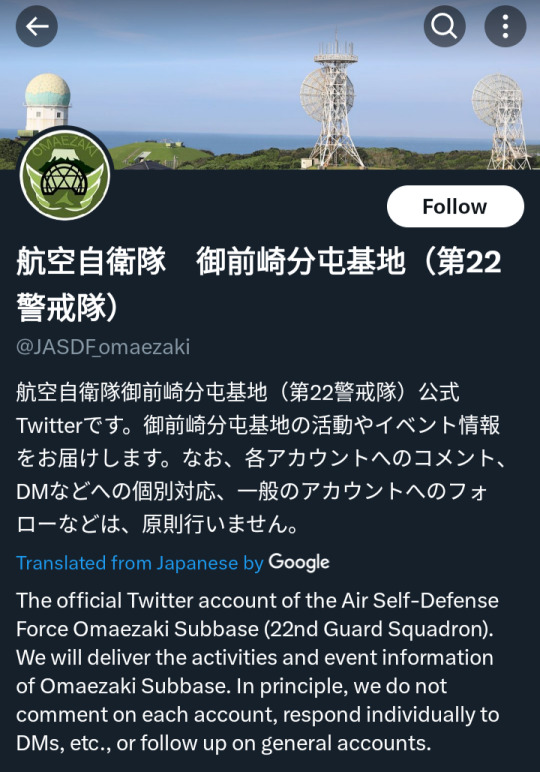
107 notes
·
View notes
Text


Mi-17 4K-15214 of doomsday cult and terrorist organization Aum Shinrikyo.
In 1992, Aum Shinrikyo established a foothold in Russia with the assistance of Oleg Lobov, a politician in the newly formed Russian government who sought assistance from Aum's leader Shoko Asahara for the funding of a new Japanese school in Russia. Kiyohide Hayakawa, with the help of Lobov, was able to make connections within the Russian defense apparatus. He, along with a delegation of other Aum members, received training from Spetsnaz units, acquired a number of Soviet military manuals that had been translated into Japanese and managed to procure a brand new AK-74 assault rifle. The rifle was successfully smuggled back to Japan and was used as a model for Aum's own production of the AK-74 at a secret Aum weapons factory in Kanazawa.

Kiyohide's group also returned with 4K-15214, a 1992 manufacture Azerbaijani Mi-17 military transport helicopter painted in flash white. Kiyohide's group carefully documented their exploits in Russia, and a recording of their expedition eventually fell into the hands of Japanese police officials. It is viewable (in part) in this Japanese TV documentary: https://youtu.be/bFwpKPNdLCM
Originally manufactured for the Soviet armed forces under the registration number CCCP-152, the helicopter was transferred to Azerbaijan Air following the dissolution of the Soviet Union. Re-registered as 4K-15214 in civilian service in Azerbaijan, Aum legally imported the helicopter to Japan in 1994.
4K-15214 was intended to be used as a delivery system for chemical weapons over Tokyo, presumably using modified crop dusting equipment. Aum also purchased two radio-controlled helicopters (apparently under the codename "Hercules") with the goal of using them to remotely spread Sarin or other chemical agents. After both of the Hercules helicopters crashed during testing, Aum appears to have given up on the aerial spraying of chemical weapons entirely, instead opting for less complex methods.
Early attempts to spray Sarin utilized pesticide sprayers, but these proved unreliable. Aum eventually used a modified refrigeration truck to spread poison gas, but when this also failed to have the desired effect, individual cult members were selected to deliver the agents by hand. On March 20, 1995, members of Aum entered the Tokyo Metro carrying liquid Sarin in plastic bags wrapped with newspaper. Each Aum member laid their pouches in predetermined locations before puncturing them with the tip of an umbrella. The poison gas flooded the cramped train cars and subway tunnels killing 14 people and injuring hundreds more. It remains the deadliest terrorist attack in Japan's history and the deadliest act of chemical terrorism ever.
Investigators immediately suspected Aum Shinrikyo was behind the attack. Shortly thereafter, members of the Japanese police and Self Defense Forces (including members of the JGSDF's 1st Airborne Brigade) personnel raided Aum's headquarters in Kamikuishiki, where they unearthed not only Aum's weapons-of-mass destruction production facility, but 4K-15214 as well.

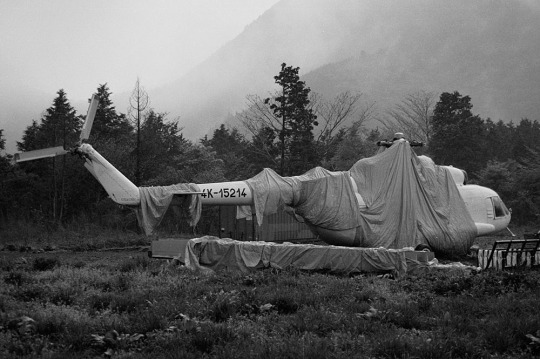
The Mi-17 was seized by police, partially disassembled and left in storage outdoors for some time while the trials against Aum progressed. In 1998, 4K-15214 was sold (at a low price) by the Japanese government to Djibouti and reregistered as J2-MAW. It entered service with the Djibouti Air Force (DAF) in 2001. It was repainted in a dark green at some point after the transfer, and now bears a desert scheme.

185 notes
·
View notes
Text

🪄 🔮 ╰ anna sawai , 30 , cis woman , she/her 𐫱 › hey , isn’t that EMIKO YAMAZAKI ? i’ve heard that they’ve lived in bearhold for eighteen years but back for two years . rumor has it that they can be rather taciturn and passive , but hey , that’s just in their nature as a WITCH . they totally make up for it by being optimistic and quick-witted . if you’re looking for them , you can probably find them at their work as an ARCHIVIST at great bear library .
[ ✰ ] PINTEREST.
[ ✰ ] WANTED & ESTABLISHED CONNECTIONS ( WIP ).
penned by HECATE ( she/her , 21+ , pst )

001. ↻ BASICS .
[ ✰ ] full name: emiko yamazaki
[ ✰ ] nickname(s): emi, mika
[ ✰ ] age: 30
[ ✰ ] date of birth: 01/18
[ ✰ ] place of birth: bearhold, wa, usa
[ ✰ ] ethnicity: japanese
[ ✰ ] nationality: american
[ ✰ ] gender: cis woman
[ ✰ ] pronouns: she/her
[ ✰ ] orientation: bisexual / biromantic
[ ✰ ] language(s) spoken: japanese, english, spanish, greek
[ ✰ ] mbti: INFP
[ ✰ ] element: air
[ ✰ ] zodiac: capricorn
[ ✰ ] character inspiration: kira yukimura ( teen wolf ), mackenzie mchale ( newsroom ), stephanie brown ( dc comics ), jubliation lee ( marvel comics ), alice cullen ( twilight )
002. ↻ BACKGROUND .
NOTE: this is a quick summary / tldr of emiko's background . for a more detailed bio , please CLICK HERE !
( death mention tw ) born the youngest of two into a seemingly ordinary life in bearhold . raised in a family of witches that've been integral to the bearhold community . and while quiet and often daydreaming , emiko is resilient . more often times than not , she doesn’t quiet realize that . she’s dealt with the sudden death of her father , her mother slowly having less time with their children and in essence , forced to grow up . but , she still maintains a cheerful and optimistic demeanor . a warm smile masking a deep longing to escape bearhold's idyllic nature before college became her ticket out . and due to a health scare back home , emiko finds herself back in her hometown after years of being away .
003. ↻ HEADCANONS .
NOTE: this is a work in progress so more will be added at a later time !
obtained a degree in both history and classics . got her masters in archives and public history
before moving back to bearhold , emiko was working archivist at the met and was on track to become managing archivist
has been back in town for two years and to pass the time has taken up a job as an archivist at the local library
a sweet treat girlie through and through . honestly loves pastries and would probably try to fight you if you try to come between her and a pastry
has a black cat named nori that traveled back to bearhold with her
a sucker for sitting in cafes to read . will often be nursing a honey latte or a matcha latte
unexpected but since moving to new york , emiko started taking jiu jitsu classes as a form of self defense ( yeahh she said small town to big city ? safety first ! )
3 notes
·
View notes
Text
Godzilla Raids Again, 1955
Godzilla returns with a vengeance, and this time he’s not alone.

With the success of Gorjira, Toho wanted to give new fans more, but how would they after Godzilla was killed? Executive producer Iwao Miri told Tomoyuki Tomaka to start production on another Godzilla movie. Miri wanted a reasonable explanation for a revival of the great monster, and Tomaka went to work immediately.
Ishiro Honda was pegged to direct the movie, but he was working on another film. Tomaka collected the creative team from the first movie to help and a new director, Motoyoshi Oda. After weeks, the creative team finished the screenplay and production started. Here is the magic they created:

Marine Fisheries KK in Osaka is a successful fish manufacturing company makes fish products. It’s success relies on two pilots searching for pockets of fish in the Pacific Ocean. Shoichi Tsukioka (Hiroshi Koizumi), and Koji Kobayashi (Minoru Chiaki), report their findings to the control operator who is the owner’s daughter, Hidemi Yajima (Setsuko Wakayama). Hidemi and Tsukioka are a couple madly in love.
On a routine flight one day, Kobayashi’s plane has engine problems and he makes an emergency landing on a nearby remote island, Iwato Island. He calls headquarters to report his situation; Hidemi informs Tsukioka who then flies to the island to rescue his friend. Kobayashi is spotted, and Tsukioka lands nearby. Just as they were leaving, strange noises from beyond a cliff caught their attention, so they go and check it out. They’re shocked to find two monsters fighting, one is recognized as Godzilla, but the other one isn’t familiar. The men watch in horror as the battle rages on. The mobsters fight so fiercely that they fall off the cliff and into the ocean. Tsukioka and Kobayashi escape unscathed and quickly return to Osaka and report this to authorities.
The JSDF, Japanese Self Defense Forces, and a team of scientists led by Dr. Yamane to discuss the mobsters on Iwato Island. Dr. Yamane confirmed the one monster is in fact Godzilla and the new one as Anguirus based on a report written by a Polish scientist. Great monsters do in fact exist. Godzilla and Anguirus had been dormant underground for centuries until they were disturbed by atomic blasts from nuclear testing performed by the American Navy in the Pacific. (Brilliant!)
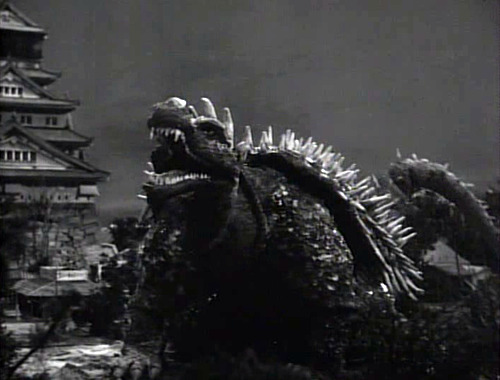
This time, Osaka was the unfortunate location for Godzilla’s raid because it was closest to Iwato Island. The defense team reviewed footage from the last Godzilla attack in Tokyo a year ago. The monster was killed by the Oxygen Destroyer, and a powerful weapon like that doesn’t exist. How would Osaka defend itself? Dr. Yamane suggested that Godzilla was light sensitive, observed from the Tokyo footage, and a citywide blackout would be the best defense. They could use flares to lure it to Osaka and use their military weapons to defeat Godzilla.
The JASDF, Japanese Air Self Defense Force, sends planes to search for Godzilla and he’s spotted moving towards the Kii Channel between Wakayama Prefecture and Shikoku. Mr. Yamaji, Hidemi’s father, is concerned because Godzilla could destruct his valued fishing production that he couldn’t afford to lose. Godzilla then changes his course and is now heading towards Osaka Bay. Authorities order an evacuation and Tsukiaka and Koboyashi go to the cannery with Mr. Yamaji. Meanwhile, convicts are being escape from an evacuation transport. They lead the police in a chase and crash into an oil refinery. The explosion attracts Godzilla and he goes towards it.
Mr. Yamaji and everyone evacuate the cannery and unbeknownst to them, the escaped convicts enter the business to hide. But no sooner than later, the convicts are killed when the monsters destroy the business. Destroying everything in their path the battle ends for Anguirus when Godzilla kills him with his atomic breath. Godzilla returns the sea.

Later, Mr. Yamaji relocates his business to Hokkaido. Tsukioka is reunited with Tajima, a friend from college and the war; Tajima works for the JASDF. The friends join Yamaji and friends for dinner. It was there that Kobayashi tells Hidemi he’s fallen for a woman, but doesn’t say whom. She tries to persuade him to tell her, but he won’t. The dinner party falls silent when a news flash reports a ship was sunk by Godzilla.
Tsukioka volunteers and helps the JASDF search for Godzilla the morning after the sinking. He flies out to the location of the downed ship and spots Godzilla at Kamiko Island. Kobayashi joins Tsukioka who is trying to prevent Godzilla from leaving the island. Meanwhile, Hidemi finds Kobayashi’s diary and finds her picture is in it. She becomes emotional learning she’s the one he loves, but she is in love with Tsukioka. Kobayashi joins his friend circling Godzilla but is struck by an atomic blast and crashes into the mountain peak. The crash causes an avalanche that buries Godzilla and this is how the JASDF decides to use this method to stop Godzilla.
Everyone who knew Kobayashi is distraught, especially Hidemi. Tsukioka wants to aid the JASDF, but Tajima won’t allow him to because of Kobayashi. The JASDF flies to Kamiko Island and bombs the ground creating a wall of fire to prevent Godzilla from leaving while another group of planes shoots missiles into the mountaintop causing avalanches to subdue the great monster. Tsukioka flies out to the island to witness the attack and watches Godzilla fire one last blast before being completely buried by the downfall of snowy rubble. Knowing Godzilla is defeated, Tsukioka tells his best friend, Kobayashi, that they’ve won and he can rest in peace.
Wrap up
Godzilla Raids Again was released in Japan April 24, 1955 and an English-dubbed version was released by Warner Bros. in America May 21, 1959 under a different name: Gigantis, the Fire Monster.

The Japanese version was released in Japanese-American theaters prior to the new adaptation and the audiences reception wasn’t received with the same excitement as was the first movie, but it did draw a moderate amount of money compared to what the first one profited. Tanaka claimed that the creating team had very little time to make this movie and he didn’t much care for it personally.
Despite the moderate profit and less enthusiastic reception, the movie is credited for paving the road for other great Godzilla movies.
I did enjoy the movie. Despite the mad rush deadline to meet, I think Tanaka created a good enough story that allows a scientific reason for Godzilla’s existence.
I enjoyed how the original movie and this one had similar romance dilemmas. The first movie, Emiko and Ogata are in love, and Dr. Serizawa is a friend who likes Emiko. Serizawa dies to save Japan. This movie, Hidemi and Tsukiyaka are in love and their friend Kobiasha likes Hidemi. Kobiasha’s death inspired a defense tactic to defeat Godzilla. Actors in both movies were outstanding. They made us believe Godzilla was real, none more so than the extras recruited for evacuation scenes.
Cast and crew
Director: Motoyoshi Oda
Special effects: Eiji Tsuburaya
Screenplay: Takeo Murata and Shigeaki Hidaka
Story: Shigeru Kayama
Produced by: Tomoyuki Tanaka
Score: Masary Sato
Starring: Hiroshi Koizumi, Setsuko Wakayama, Minoru Chiaki, Takashi Shimura
Movie Grade: 0.0 to 4.0
Score: 3.7
Photo references: Getty Images
#godzilla#anguirus#godzilla resurgence#godzilla raids again#monster#monster movies#movie theater#movie release#movie review#japanese movie#movies#movie time#movie talk#movie recap#thriller movies#movie recommendation#movie reaction#movie classics#classic#movie characters#movie critic#movie critique#godzilla movies
16 notes
·
View notes
Photo

Kawasaki T-4
The Kawasaki T-4 is a Japanese subsonic intermediate jet trainer aircraft developed and manufactured by the commercial conglomerate Kawasaki Heavy Industries. Its sole operator is the Japan Air Self-Defense Force, in part due to historic restrictions on the exporting of military hardware, The T-4 has been used by the JASDF's Blue Impulse aerobatic team as well as liaison duties with most fighter units.[1] The first XT-4 prototype flew on 29 July 1985, while the first production aircraft was delivered during September 1988.
77 notes
·
View notes
Text
A correction on Karasuma’s career
(...And Takaoka’s too I guess)
A fandom wiki can be a fickle thing. Sometimes helpful. Sometimes, straight up misinformation.
Some time ago, I woke up in the middle of the night, pondering something about a character’s past that I immediately needed to check- as one is bound to do when they should be asleep. Said character? Karasuma Tadaomi of Assassination Classroom (as some mutuals will have cleverly guessed from the title).
...Except. Something was wrong. I’m not talking about his description as a ‘handsome young man’, because it’s supposed to be true within canon (despite visual evidence to the contrary). I’m talking about facts that are harder to disprove just by a glance- especially since the source isn’t written.
“I’m... pretty sure Karasuma never was in the Air Force, that doesn’t sounds right.”
“Warrant Officer? ‘According to the manga, Karasuma’s dress during his career-’ where. Which panel is it and where can I compare it to an actual uniform.”
“Uh, Takaoka’s profile doesn’t help much more. ‘Takaoka and Karasuma were in the same squad in the military but were in different sections.’ That’s not possible, as a squad is part of a section. And unsourced too.”
So. Even though I don’t participate in the fandom. I had to do something. Edit the wiki? Well I don’t know if I need permission to do that, so no. But, there’s something much easier I can do, one thing I’m pretty used to.
Complain about it on Tumblr!
So, I looked up what I could. The official French translation, the English scans. His Graduation Album’s profile just in case, though it was unhelpful. Hunted down his tankobon’s profile, and, bingo, a career path! ...With a few differences from the French translation. Hmm. At this point I would need to look at the raws.
Thankfully, I do have Roll Book Time, in paper format, a gift of years ago from my good friend and sweetheart. Unfortunately, I don’t actually read Japanese- but as if that stopped me in the past! By now I’m an expert at painfully looking over radicals to search for accurate kanji on jisho.org, one at a time. It’s long and tedious and in the end I still rely on Google Translate, but at least I’m going somewhere.
So, without further ado! Let me show you what I’ve got!
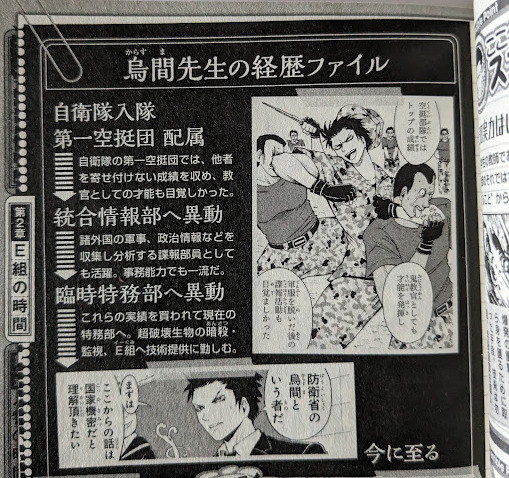
[Alt: Photo of a half page from the Roll Book, describing Karasuma’s career. The text is in Japanese, and illustrated by two panels from the manga. One shows Karasuma in camo uniform training recruits, the other shows him at the start of the manga, presenting himself to the 3-E. ]
For those of you who wants to read the Japanese text, but it is too small or the pic isn’t showing, here the transcription:
烏間先生の経歴ファイル
自衛隊入隊
第一空挺団 配属
自衛隊の第一空挺団では、他者を寄せ付けない成績を収め、教官としての才能も目覚しかった。
統合情報部ヘ異動
諸外国の軍事、政治情情報などを収集し分析する諜報部員としても活躍。事務能力でも一流だ。
臨時特務部ヘ異動
これらの実績を買われて現在の特務部ヘ。迢破壊生物の暗殺・監視、E組ヘ技術提供に勤しむ。
As for some sort of translation, here’s a little something to get the gist of it, but don’t consider this as a totally accurate translation.
Karasuma-sensei’s background file
Enrolled in the Self-defence Forces
Assigned to the 1st Airborne Brigade
In the SDF’s 1st Airborne Brigade, his talent was unmatched. His talent as an instructor was also remarkable.
Transferred to the Defense Intelligence Office
He had been active as an intelligence agent who collects and analyses military and political information in other countries. His office ability is also top notch.
Temporary transferred to the Special Services Office
Due to his past results, he was brought into the Special Affairs Department. He works with the monitoring / assassination of the “destructive creature”, and teaches his technique to Class E.
So, the first point of this.
The Japanese Self-defence Force (which I will abbreviate in JSDF) is, like most if not all armies, divided into ground, air and naval forces.
You would think the 1st Airborne Brigade is part of the Japan Air SDF, since there’s ‘airborne’ in the name. And you would be wrong! It is part of the Japan Ground SDF, and my, what a part it is. They’re considered among the toughest soldiers of the JGSDF, deserving of their “The Matchless Elite Second To None” motto. While the JSDF are supposedly defensive, as the name said, for legal reasons (they technically can’t call themselves an army because Japan can’t have one), this brigade is considered as one of the few with an offensive capability. Yeah, fitting for Karasuma!
(And yes, this means Takaoka has been part of it too. Which... kinda explains why he underestimated Nagisa so much. If you’ve been in an elite troop for years, you can let a scrawny teenager with a knife get closer to you a few steps further, just to prove a point.)
Then, we have what the tankobon profile’s translator chooses to translate as “Information Bureau”, but I choose Defense Intelligence Office.
You see, the original text was 情報部. Now, Matsui has been known to slightly modify the name of actual places/schools rather than reference the actual thing (dunno if he’s required to do it or it’s a personal choice). And, if you take 部 (office, bureau, department- I prefer ‘office’ since it’s found in the translation for some Ministry of Defense’s extraordinary organs) and add 本 to make 本部 (headquarters), you get 情報本部, which is the Japanese name of the Defense Intelligence Headquarters! Which is still part of the Ministry of Defense, so it makes sense the transfer could be done.
(As for Takaoka- The first page of chapter 38 shows us a shadowed Takaoka, with his chief going ‘It’s a hidden ball trick, courtesy of our Information Bureau’. So I guess it’s either a natural advancement career, either he followed Karasuma there, or this guy has the worst of luck.)
Finally- Special Services Office- or Division, as per the English scans. But the tankobon profile translation talks about ‘Special Forces’? Well, I can disprove that.
The Special Forces Group of JGSDF is 特殊作戦群 in Japanese. Meanwhile, 特務部 is... nowhere close from that, except there’s 特(special) in their names. Furthermore, we do have an 部 again at the end, which implies an office/department/division/etc. Given the explanation in Karasuma’s profile, I would assume this office was created specifically to deal with Korosensei, and various agents were transferred to it temporarily? Notably, Karasuma and Takaoka.
--
Now, that solves it for the Air Force misunderstanding. What about Karasuma’s rank, though?The fandom wiki mentions his uniform in the manga. Which turns out to be one panel. It... makes sense, since Karasuma is no longer part of the JSDF, having transferred, and so wouldn’t be able to use a military uniform on important events ; the French translation of Karasuma’s chief’s words in his flashback from chapter 38 even says “After you abandoned your military uniform [...]”. What is this famous panel, then?
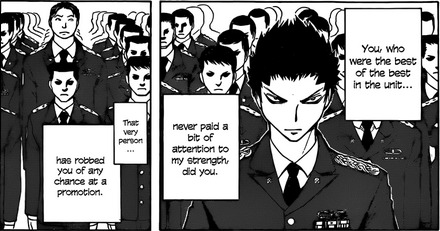
...Well, that’s going to be tricky. We don’t have a view of the arms themselves, though he doesn’t seem to have a patch. Then we have the notch lapel insignia, but those meant for rank are put on the upper notch- the lower notch is for the branch of service, from what I gathered in photos. (And I mean, it would be ridiculous as a rank insignia- it seems to have three dots in a triangle, so either a captain or a colonel, can you imagine this, a colonel? A guy in mid-twenties? Ridiculous)
What about the shoulders, then? Well. Let me tell you a thing.
...Finding things about Japanese formal dress military uniforms is super annoying. US uniforms? Sure, no problem. French uniforms? If you type in French, sure. Japanese Uniforms? Oh, did you mean WWII Imperial Army uniform? No? You’re sure? Because this is what you will get. Oh, sure, Wikipedia has a page on the ranks and insignia of the JSDF. But it doesn’t seem to account for those formal epaulets, which are only used in ceremonies.
But! There’s a silver lining! Typing 陸自 儀礼肩章 (JGSDF formal epaulets) in a pic search, we can then click on the ones that interest us and look for the grade. (Though, some of them seem to come from Yahoo Auction, and are unavailable to me). So, on our manga panel, we have three dots on the knot, plus a little one at the end to pin it to the uniform.

Something like this. Now those specific ceremonial shoulder insignia are for a 一等陸佐 (or 1等陸佐), which correspond in the US Army to... uh. Hm. Wait. Let me check. Gotta be a mistake. He can’t be a colonel.

...A bit smaller but that will do. Notice how the knots have one less... wire? Thread? Look, I’ve put way too much energy into this post to start worrying about words. Anyway, the number of stars might be the same, but the whole epaulet is different. And we even have the less formal insignias on the side! Those are for a 1等陸尉, which corresponds to... Captain.
...No, seriously.
I mean, you can check on other sources if you want. Wikimedia even has this photo if you don’t believe me.)
As for Takaoka (as well as every man present in the panel), it’s small but you can see two stars on his shoulders, so he has the grade just below- 2等陸尉, which corresponds to first lieutenant. But hey, maybe Matsui and his assistants took a random uniform as reference! You know, the anime tends to have interesting background details in the classroom, so maybe they would also have been careful with this!

...Ah, yeah, not really. What about Takaoka?
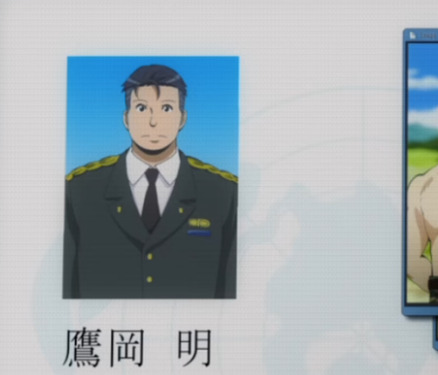
...Well. Not very helpful either. It does show us he has the service ribbon for the Medal with Blue Ribbon, a Japanese medal of honour awarded to individuals who have made significant achievements in the areas of public welfare or public service. As for the weird infinity sign- this pin badge is likely the same as Karasuma’s in the manga, which is not quite clear on the scan, but I can confirm on the tankobon that it’s the Ranger Courses pin badge. The fact it is golden means he specifically completed the Fuji School one, which is needed to be a course instructor or an officer.
...So, I have no idea where this Warrant Officer rank came from. It would make more sense, but it seems like somehow, Karasuma reached captain rank. Despite being in his mid-twenties (he’s 28 by the time of the manga, which is to say, after he spent time at the Defense Intelligence Office). Seriously, is it too much to ask for a bit of realism in my supersonic giant yellow octopus manga?
...One mystery remains, though.
...Where the hell did Karasuma find the time to get a valid teaching license? Because he does tell Gakuhô he has one early on, and being an instructor for military recruits certainly doesn’t require the same license as to teach middle-schoolers. Did he get a special rush training between the time Korosensei said he would be 3-E’s teacher and whenever chapter 3 happens? Or did he just happen to have one before? He probably entered the JSDF as soon as he got the minimum age, so I can’t see how. Matsui please show us your notes.
#assassination classroom#ansatsu kyoushitsu#assclass#karasuma tadaomi#takaoka akira#long post#...this was originally going to be way longer as I narrate my struggles in searching for information#but I keep pushing back this post because it would take so long to write so. Guess y'all got lucky
23 notes
·
View notes
Photo


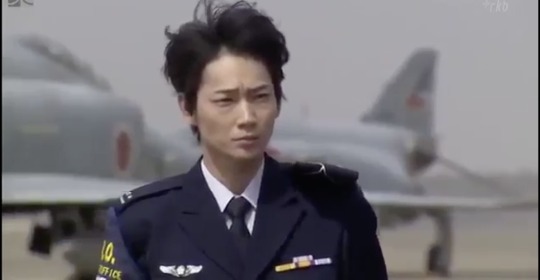
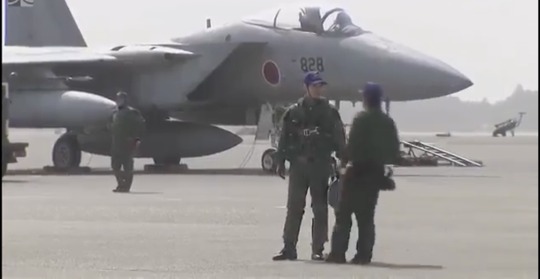
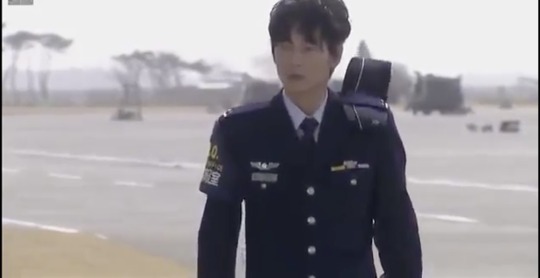





Soratobu Kouhoushitsu (Public Affairs Office in the Sky) Ep 1
Losing your childhood dream which makes you feel happy and alive, feels like losing your purpose as you’ve worked hard all your life wanting to achieve that dream. But once you lost it, you don’t know what to do next.
#soratobu kouhoushitsu#public affairs office in the sky#go ayano#ayano go#yui aragaki#aragaki yui#japanese drama#j drama#dorama#jdrama#japan#asian drama#military drama#japan air self-defense force#f-15#fighter pilot
8 notes
·
View notes
Text

The first island chain forms one of three island chain doctrines within the island chain strategy in US foreign policy.[2]
Much of the first island chain is roughly situated in waters claimed by China.[3] These include the South China Sea, within the nine-dash line, as well as the East China Sea west of the Okinawa Trough.
US General Douglas MacArthur pointed out that before World War II, the US protected its western shores with a line of defense from Hawaii, Guam, to the Philippines. [...] The WW2 victory allowed the US to expand its line of defense further west to the coast of Asia, and thus the US controlled the first island chain.[4] Between the end of WW2 and the Korean War, MacArthur praised Taiwan, located at the midpoint of the first island chain, as an 'unsinkable aircraft carrier'.[5]
In April 2014, the United States Naval Institute (USNI) assessed that the first island chain is the most effective point to counter any Chinese invasion.[6] The US could not only cut off the People's Liberation Army Navy from entering the western Pacific, but also predict where they may move before trying to break through in the first place. The US and first chain countries are able to coordinate because of the US military's freedom of navigation in the first chain block.[7] In June 2019, USNI called for a blockade of the first island chain if armed conflict broke out between China and the United States.[6]
Andrew Krepinevich argued that an "archipelagic defense" of the countries that make up the first island chain would make up a big part of the implementation of the national defense strategy of 2018.[8] A 2019 report by the Center for Strategic and Budgetary Assessments "proposes a U.S. military strategy of Maritime Pressure and a supporting joint operational concept, “Inside-Out” Defense, to stabilize the military balance in the Western Pacific and deny China the prospect of a successful fait accompli." The first island chain plays a central role in the report.[9] In 2020, the United States Marine Corps started shifting its tactics in conjunction with the United States Navy to be deployed along or near the first island chain.[10] In 2021, the United States Marine Corps announced a goal of three additional Pacific-based regiments.[11] [...]
Around 2009 Japanese military strategist Toshi Yoshihara and Naval War College professor James R. Holmes suggested the American military could exploit the geography of the first island chain to counter the People's Liberation Army Navy build-up.[10] The Cabinet of Japan has also passed defense white papers emphasizing the threat posed by the People's Liberation Army Navy in the first island chain.[13][14][15][16]
In the later years of the 2010s, Japan started deploying military assets to Yonaguni and its other islands to counter China's presence along that area of the first island chain.[17][18]
Japan's strategic position in the first island chain began with US-Japan joint efforts to counter Soviet expansion. The Japan Self-Defense Forces currently plays the role of protecting US military bases and preserving military strength in East Asia. As for Japan's Territorial Protection Self-Defense Forces, which mainly rely on islands in southern Japan adjacent to the Yellow Sea and the East China Sea, Japan has military advantages in anti-submarine, air defense and sea mine technologies.[19][...]
In the first island chain, Taiwan is considered of critical strategic importance.[21] It is located at the midpoint of the first chain and occupies a strategic position.[21]
The Second Island Chain can refer to two different interpretations, but the version most commonly used refers to the island chain which is formed by Japan's Bonin Islands and Volcano Islands, in addition to the Mariana Islands (most notably Guam, an unincorporated American overseas territory with a heavily fortified military base), western Caroline Islands (Yap and Palau), and extends to Western New Guinea.[1] The chain serves as the eastern maritime boundary of the Philippine Sea.
38 notes
·
View notes
Text

28th July, 1935. First flight of the Boeing B-17 strategic bomber, later to be named the ‘Flying Fortress’. The type was designed to conduct high altitude operations using the newly developed Norden bombsight, and was intended to protect itself against attack with heavy defensive armament. Combat experience, especially over Europe, would prove that precision bombing was rather more difficult in practice than theory, and fighter escort was indispensable. Over 12,000 B-17s were built.
Initially used operationally by the RAF in limited numbers (see my post of 8th July), the B-17 was first saw service with the USAAF in the Pacific. Famously, a flight of the aircraft arrived over Pearl Harbor during the Japanese attack on 7th December 1941 and B-17s suffered significant losses during the initial phases of the Pacific war. Further use during the battles of Coral Sea and Midway yielded poor results, though the type had more success during the battle of the Bismarck Sea. Fewer than 200 B-17s served in the Pacific, and had largely been replaced by the longer ranged B-24 in the theatre by mid-1943, though some were later used in the search and rescue role.
It was over occupied Europe that the ‘Flying Fortress’ would make its name. Limited operations from Britain began in August 1942 and initially it seemed that the concept of a self-defending bomber formation was vindicated. However, once larger scale raids into Germany began in 1943, losses from Luftwaffe fighters quickly mounted. Though the B-17 gained a reputation for its ability to absorb combat damage, and German pilots respected its firepower, this was not enough. Following two operations against Schweinfurt which cost over 120 aircraft, deep penetration raids into Germany were temporarily halted.
With the arrival of the P-51 Mustang in early 1944, the B-17, alongside the B-24, was able to operate as far as Berlin, though losses to German defences remained significant for some time. The type was key to the Allied daylight bombing offensive and inflicted massive damage, though extravagant claims of ‘pickle barrel’ precision bombing proved groundless. For a variety of reasons, not least the prevailing weather conditions and cloud cover, USAAF accuracy was often little better than that achieved by the RAF at night.
Quickly phased out of use as a bomber after the war, many B-17s remained in service in a variety of secondary roles. These included air-sea rescue, reconnaissance, mapping, atomic sampling, airborne early warning, drone targets and even CIA special operations. Others were converted for civilian roles, with some B-17 firebombers (a number of which have since found homes in museums) remaining operational into the 1980s. B-17s also served with a variety of air forces and civilian operators around the world including in Brazil, Israel, Portugal and France.
Pictured:☝️
1) Prototype Boeing Model 299/XB-17. Early Fortresses had significant differences to later models, including waist blisters and a ventral ‘bathtub’ for the gunners.
📷 boeingimages.com

2) B-17C of the 19th Bomb Group, which was damaged and caught fire attempting to land at Bellows Field during the Japanese attack on Pearl Harbor. The crew survived, but a flight surgeon passenger was killed by a strafing Zero.
📷 warfarehistorynetwork.com

3) The YB-40 ‘gunship’ was an attempt to give B-17 formations extra firepower. Mounting an extra top turret, twin waist guns and a new chin turret, its extra ammunition load left it too heavy to keep up with the aircraft it was supposed to protect, particularly after they had released their bombs. Only 48 operational sorties were flown, with 5 Luftwaffe fighters claimed destroyed.
📷 warbirdsresourcegroup.org

4) A handful of B-17s were captured intact by the Germans. ‘Wulfe Hound’ of the 303rd Bomb Group force landed in France on 12th December 1942 and was later used by the Luftwaffe’s clandestine operations squadron, KG 200.
📷 American Air Museum FRE 8941
9 notes
·
View notes